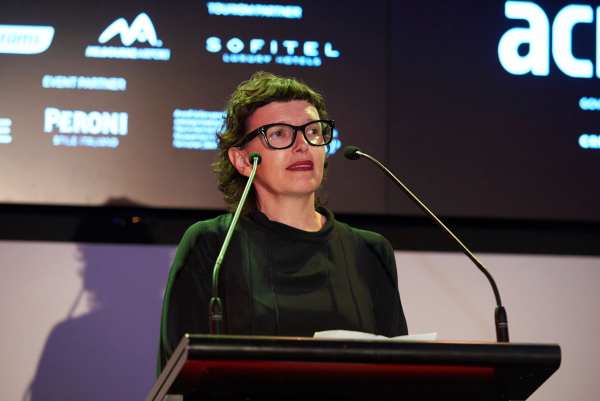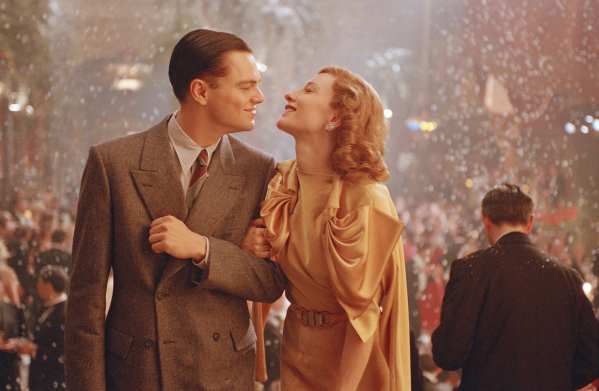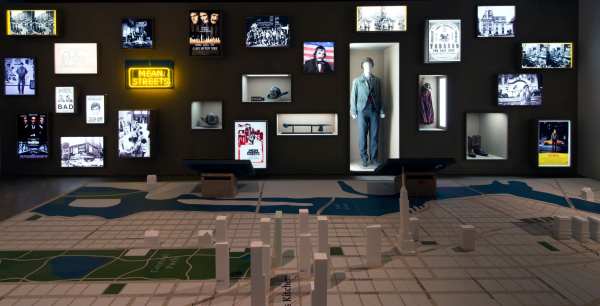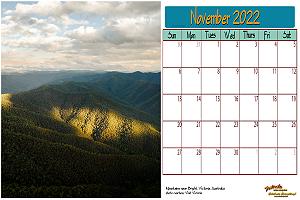Issue: Winter 2016 (July)
Interview with Fiona Trigg ACMI lead curator
This interview is published with the July 2016 Reel Life column on the Scorsese Exhibition at ACMI Melbourne. It was recorded on 3CR On Screen (3CR Film Show 11am Saturdays), interview by Melinda O'Connor

Melinda: The exhibition celebrates the work of Martin Scorsese one of the influential directors ever. Where did the exhibition originate?
Fiona Trigg: The exhibition was first mounted in Berlin at the Museum of Film and Television there and the curators there worked really closely with Scorsese's Studio in New York. So the majority of the content in the exhibition comes directly from his person archive. So they put the show together I think it was in 2013 and then it toured in a couple of places in Europe then it went to the Cinematheque Francaise in Paris and the Cinematheque added some of their own collection to the exhibition. So we're taking that expanded version and we have also gone back to Scorsese's Studio in New York and added some more material from his more recent work and some addition costumes from Sandy Pal the costume designer who has worked with him on a number of his films.
Melinda: With 600 objects and 5 of these exclusive to the Scorsese exhibition can you tell us about these five costumes that have never been exhibited before now?
Fiona Trigg: Well they're the five extra costumes that we got direct from Sandy. So there's a couple of beautiful ball gowns from The Aviator. There was one that was already in the show but we've added a second ball gown. So they were costumes worn by Kate Blanchett and Gwen Stefani who played Katherine Hepburn and Gene Harlow we also have three costumes from Hugo so there's the little boy Hugo's costume and the station inspector played by Sasha Baron-Cohen and a little dress that the girl Isabelle wore at the party at the end of the film. And we also have a really great costume from the film Gangs of New York that was worn by Daniel Day Lewis. So it's this big top hat and a long kind of trench coat, and boots and waist coat. So those costumes are really interesting to see because they are all so different and they all fit the style of the characters in those films.

Jodie Foster, Robert di Niro, Martin Scorsese making TAXI DRIVER USA 1976 Source: Sikelia Productions, New York
Melinda: Now Martin Scorsese is known for his successful working collaborations and you mentioned some of the actors and he's worked with actors like Robert Di Nero, Daniel Day Lewis, Leo Di Caprio and his editor Thelma Schoonmaker and this is highlighted in the exhibition too isn't it?
Fiona Trigg: Yes he's had a few long standing creative collaborations so I guess the most well-known is the eight films he made with Robert De Niro and those two as a partnership had an incredibly fruitful relationship. I guess those films really made Scorsese's reputation and De Niro's. They were so powerful and emotional and personal so films like Taxi Driver and Raging Bull. You know they kind of heralded a great creative partnership. I guess the films he's made with Leonardo DiCaprio, the last four, are much different types of films. They're really big budget, studio films a really different approach to performance and to storytelling but they've possibly been bigger successes at the box office. So it's just interesting to see across the whole breadth of his fifty year long career. That he's had these two really major but very different relationships with actors. And of course with Thelma Schoonmaker, his editor. He's worked with on every feature since Raging Bull. And they're both in their seventies and they just keep working together. So it's a really amazing creative relationship.
Melinda: Now Martin Scorsese has been such an advocate and sponsor of film preservation and restoration and it's great to see some of the clips in the exhibition can you tell us about some of that?
Fiona Trigg: Yes well in the late 1970s Scorsese noticed that many film prints he was seeing not just of his own films but of cinema in general were fading to pink. And he was really upset about this and he lobbied Kodak, along with some of his director cronies, he mounted a really big campaign actually to get Kodak to produce a colour fast stock and he made Raging Bull in black and white at about the same time and I think part of that was because why would he make a film in colour if it was only going to last five or ten years before it faded. So that got him started on the film restoration bent and he subsequently set up the Film Foundation in 1990 and that raises a huge amount of money to restore and preserve world cinema. He then set up the World Film Foundation which looks at restoring films from Africa and Asia, films outside of the mainstream European/ American nexus. So he has been an incredible advocate for cinema culture.

Leonardo DiCaprio (Howard Hughes) and Cate Blanchett (Katharine Hepburn) THE AVIATOR, USA 2004 Source: Sikelia Productions, New York
Melinda: Yes he really has and it is really wonderful to see those clips you have too
Fiona Trigg: Of the restoration process yes so you can see the work that they do before restoration and after and it's just bringing great films back to life. It's a really important part of his life and his legacy I think.
Melinda: Now Martin Scorsese I think he has directed over 60 films and plus he's directed television with the recent Boardwalk Empire and I didn't realise he directed Michael Jackson's video clip Bad. Were there any surprises for you in the Scorsese exhibition?
Fiona Trigg: I guess I was reasonably familiar with his work I possibly hadn't looked at all his documentaries. So he is a really fantastic documentary film maker as well as a feature filmmaker. And he has made lots of films about music and about cinema history. There's a really incredible short documentary I think it's less than an hour called American Boy made in the 70s. It's a portrait of an actor who played a very small part in Taxi Driver he was the gun salesman in that film and it's just an extraordinary knife edge ride spending one night with this particular individual telling stories from his life. I think that when you look at those documentaries, including the documentary Italian American that he made about his parents, you really get to see the kind of fascination Scorsese has with characters and the way he is able to allow these characters to perform for him on camera and the kind of crossover of that really great dynamic energy from his docos to his feature films. It's kind of interesting to look at those docos and feature films as interlacing on lots of themes and styles.
Melinda: Another point the exhibition Scorsese does highlight is that Scorsese has worked with a lot of male actors as leads and females haven't been so much in the fore front but they're certainly been there in his films.
Fiona Trigg: Yes it's true most of his films are driven by male actors and I think he's really interested in masculinity and its failings or its stresses. He comes from a very conservative, Italian/ American background in New York and he was brought up in the Catholic Church. And I think, he's spoken a lot about this, notions of masculine guilt and kind of hesitancy in relationships with women is very clear in his work. He does have a lot of really interesting female characters, I mean the female characters in his films are never just a love interest that the man wins at the end I mean no one tends to win in a Scorsese films things always seem to end up pretty badly but the female characters are really dynamic and rich and interesting and he likes to explore the difficulty of achieving a successful romantic or love relationship and I think he does that really powerfully. But no he doesn't do strong female leads except for Alice Doesn't Live Here Anymore which he made in the early 70s which is a pretty powerful film.
Melinda: Now can you tell us some of the personal items that are in the Scorsese exhibition?
Fiona Trigg: Yes it's not really a biographical exhibition the first part of the exhibition is called Family and that really looks at his family life and he has always been close to his parents and they feature in a lot of his films so there's a huge range of photographs and items from his mum and dad's apartment that he lived in when he was a kid but apart from that there's some really great letters between Scorsese and a range of other filmmakers: some of them are to do with the campaign for film restoration that he's run others are just more kind of personal, friendly letters; like there's a sweet note from Jean Luc Goddard and Robert Bresson just kind of chatting away to Marty so that's kind of good to see those. And there is also a fantastic diary. He's a real obsessive cinema watcher so there is a diary open at a double page spread that shows all the films he watched that week and it is 2 or 3 a day. It's just really interesting to see those kind of things in the show I think.
Melinda: Martin Scorsese seems to have such an incredible work ethic doesn't he and application. I mean he's talented and gifted as well but just his conscientiousness.
Fiona Trigg: Yeah and I think we can say obsession really. So there is a great story board in the exhibition that he drew when he was eleven for a film he fantasised about making called The Eternal City which is a Roman kind of epic and he has drawn out the title sequences and its written and directed and produced by Martin Scorsese and it's in 75 millimetre because he wanted it to be really big and he's got all the shots there and you can tell he already understands film language he at eleven. So I don't think he ever let up from that time on. He's still working, he's still finishing his last feature film. And his output is quite incredible really.
Melinda: What is your favourite piece or aspect of the Melbourne Scorsese exhibition at ACMI?
Fiona Trigg: I'm a bit biased I like everything.

Exhibition section "New York" Photo: Deutsche Kinemathek / M. Stefanowski, 2013
Melinda: Why you're thinking about that I was going to say I was really taken by the contact lens with an eagle on it worn by Daniel Day Lewis in Gangs of New York and the fact you have a microscope there.
Fiona Trigg: Yes well the character that he played had a glass eye and the glass eye had an eagle painted on it so they made a contact lens that covered Daniel Day Lewis' entire eye. Apparently it was really uncomfortable for him to wear but they offered us it in the show and we thought why not. So we've set it up with a magnifying glass.
But I think one of the things that are my favourite in the show are some of the hand written notes that Scorsese has scribbled on his scripts and you can just see the little pictures he has drawn for the next shots he wants to shoot and they're all numbered with arrows and diagrams and it's meticulously done and you can just see the level of planning that he puts into every shot. It's really great.
Melinda: And is there another aspect of the Scorsese Exhibition that you think people should leave time to see?
Fiona Trigg: The show finishes with a spectacular four screen installation that was put together for the original German curators and it runs for I think about 12 to 13 minutes and it takes motifs, visual and thematic, from a range of Scorsese films and plays them out in a evocative, powerful display. It's got great sound and great images and it gives a little immersion into Scorsese's kind of mood. I think it is really effective.
Reprinted by permission.
For posts about Melbourne events, places, news, reviews, giveaways, see our Facebook Page:
Buy from Amazon, help us fund the site









 Published in Melbourne, Victoria, Australia
Published in Melbourne, Victoria, Australia 